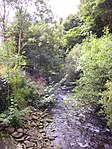Rhondda Heritage Park

Rhondda Heritage Park, Trehafod, Rhondda, South Wales is a tourist attraction which offers an insight into the life of the coal mining community that existed in the area until the 1980s. Visitors can experience the life of the coal miners on a guided tour through one of the mine shafts of the Lewis Merthyr colliery. Tours are led by former colliery workers. Rhondda Heritage Park is an Anchor Point of ERIH, The European Route of Industrial Heritage. Rhondda Heritage Park exists on the site of the former Lewis Merthyr Colliery as a testament to the coal mining history of the Rhondda Valleys, which until the end of the 20th century was one of the most important coal mining areas in the world - in an area only 16 miles (26 km) long, Rhondda alone had over 53 working collieries at one time.
Excerpt from the Wikipedia article Rhondda Heritage Park (License: CC BY-SA 3.0, Authors, Images).Rhondda Heritage Park
Bryn Eirw,
Geographical coordinates (GPS) Address Phone number Website External links Nearby Places Show on map
Geographical coordinates (GPS)
| Latitude | Longitude |
|---|---|
| N 51.6107416 ° | E -3.3875442 ° |
Address
Rhondda Heritage Park
Bryn Eirw
CF37 2NP , Trehafod
Wales, United Kingdom
Open on Google Maps









